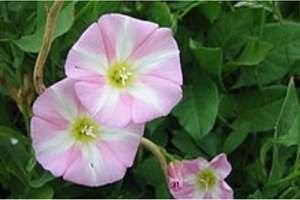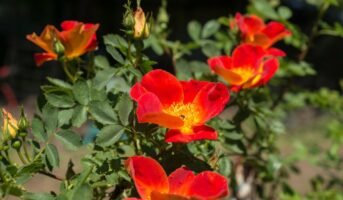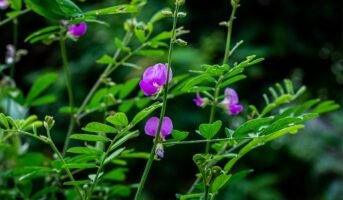Convolvulus Arvensis is a creeper that is well known for its beautiful flowers. It is commonly known by the names field bindweed, European bindweed, and perennial morning glory. The plant is native to regions of Europe and Asia. It is found in abundance in the highlands and foothills of China. These plants tend to grow rapidly and are pretty low maintenance in nature.

Source: Pinterest
Convolvulus arvensis is a beautiful plant with big white and pink flowers. Each flower is round in shape and contains around 6-7 petals in total. The outer edges of the flowers are pink, while the inner sections are white. The plant can easily climb up pillars, walls, and balcony railings to form a canopy or a green pillar. It can grow rapidly from rhizomes and doesn’t need many acres for propagation.
See also: Garden roses: Facts and tips to grow
Convolvulus arvensis: Key facts
| Name | Convolvulus arvensis |
| Common Name | Field bindweed, European bindweed |
| Origin | Europe and Asia |
| Type | Creeper |
| Height | 0.5–2 metres |
| Soil | Alkaline soil |
| Temperature | 20-35°C |
| Sunlight | Direct |
| Water | Moderate |
| Indoor/Outdoor | Outdoor |
| Flowers | Round, white and pink flowers |
See also: What is Hibiscus and how to grow it in your home?
Convolvulus arvensis: How to grow?
- The best time to plant your Convolvulus arvensis is during the spring or fall.
- You should start by digging a hole about twice as wide as the root ball of the plant, then add a layer of compost to help keep it from drying out over time.
- Next, add some water-retaining mulch, such as pine needles or straw, to help keep moisture levels up while you’re waiting for the roots to get established before planting it into your garden bed or container.
- Make sure that there’s enough room on all sides so that the plant has more space to grow.
- In areas with mild winters or where summers are short enough not to damage the plant’s root systems, it may be possible to grow it indoors under lights all year round.
- Once you’ve planted your seeds, they will need water every day until they germinate, after which they’ll need to be watered twice a week.
See also: Mango: What makes India’s national fruit so special?
Convolvulus arvensis: How to care for it?
Convolvulus occurs naturally in Europe and Asia. The plant grows everywhere but prefers mountain soil. It doesn’t need rich and fertile soil and is actually pretty low maintenance. You can easily grow the plant at home without any problems. The plant is a good selection for beginners who do not have much experience with gardening.

Source: Pinterest
Soil
Convolvulus arvensis prefers well-drained soil that has nutrients. There is no need for humus-rich soil since the plant can even grow beside dumpsters. You can use normal garden soil mixed with some compost. Additionally, you can use perlite to make it more permeable. It grows well when directly planted on the ground, so it’s better to grow it outdoors. However, you can simply pot the plant on your balcony if you lack space.
Water
Convolvulus requires regular watering in short intervals. It doesn’t have a high water requirement and can survive just like any other house plant. You must water these plants when the topsoil is dry upto 2 inches. Using a spray bottle or a sprinkler will also be more than enough.
Sunlight
Field bindweed, or Convolvulus arvensis, is an outdoor plant, so it does require plenty of sunlight. It would require around 5-6 hours of sunlight every day. You can plant them near a windowsill if it receives enough sunlight daily.
See also: Why is cape jasmine a flower of choice across Indian homes?
Convolvulus arvensis: Benefits
Ornamental
Convolvulus arvensis is a beautiful plant that can adorn your garden with fresh pink flowers. The creeper climbs up supportive structures, so it’s great to keep in porches, terraces, and balconies. It will add to the beauty of your garden and transform it completely.

Source: Pinterest
Medicinal
The plants also have some great medicinal benefits, so it’s important to have them in your home. A number of herbal teas are made from Convolvulus arvensis that help with certain infections and medical problems.
Here are some of the top benefits of field bindweed that are unknown to many people.
-
Antibacterial properties
The antibacterial property of Convolvulus arvensis makes the plant an excellent cure for wounds and bruises. The extract of this plant will remove germs and bacteria from wounds and prevent the spread of infection. Additionally, they can be useful in marinating personal hygiene since it inhibits yeast infection in women.
-
Laxative effects
The laxative effects of Convolvulus arvensis make it an excellent cure for constipation. People suffering from irritable bowel movements can also greatly benefit from the plant. The purgative effect of field bindweed also makes it excellent for solving digestive issues.
-
Anti-inflammatory properties
The anti-inflammatory and antibacterial properties of Convolvulus arvensis are useful for treating skin conditions and infections. They can relieve pain and swelling from allergies that can be very painful and uncomfortable for people. Additionally, the plant can cure sunburns and heal skin inflammation problems.
See also: 21 best flowers for your garden
FAQs
Is bindweed poisonous to touch?
No, bindweed is not poisonous to touch. The plants are even edible and used to make herbal teas.
Is bindweed edible?
Yes, bindweed stalks, young shoots, leaves, and roots are completely edible. However, they need to be cooked properly before eating.
Is field bindweed dog friendly?
Bindweed is completely dog friendly. If you are a pet parent, you can plant this beautiful flower in your garden.
Housing News Desk is the news desk of leading online real estate portal, Housing.com. Housing News Desk focuses on a variety of topics such as real estate laws, taxes, current news, property trends, home loans, rentals, décor, green homes, home improvement, etc. The main objective of the news desk, is to cover the real estate sector from the perspective of providing information that is useful to the end-user.
Facebook: https://www.facebook.com/housing.com/
Twitter: https://twitter.com/Housing
Email: [email protected]










